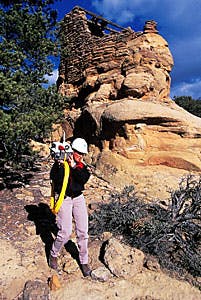Conoco's Shirley Ebert transports a seismic receiver near a ruin in the San Juan basin.Conoco Inc. has developed a technique that it says halves seismic cabling requirements, thereby protecting threatened and endangered plant and animal species.
Using state-of-the-art 3D seismic equipment, Conoco workers walked radio seismic recording devices into a 355 sq mile area of northwestern New Mexico's San Juan basin last year while exploring the basin's deeper formations for indications of oil and gas.
"(By) alternating seismic cables approximately 1/4-mile long and 1/4-mile apart, Conoco avoided dozens of native American sites, plus more than 30 locations of endangered plants and unsafe high terrain," said the company. "The innovative use of staggered seismic cables, instead of mostly continuous cabling, also improved safety for contractor seismic crews and reduced the operation's costs by more than 40%."
The technique also enabled Conoco to keep heavy-duty seismic trucks on existing roads, further protecting the environment.
Footprint reduced
Conoco enhanced a commercial computer software program that permits seismic acquisition crews to avoid environmentally sensitive areas and unsafe areas like cliffs.The software enhancement has staggered traditionally lengthy seismic cables into many shorter cable segments of only 1/4 mile in length and spaced nearly 1/4 mile apart.
"Using relatively short segments of cabling with Input/Output Inc. remote radio signals over large areas is a radical change for our industry, one that many people said could not be done," said Peter Eick, the Conoco senior geophysicist who led the design and software enhancement.
"Most important, when we come to an area with endangered plants or animals, or a dangerous cliff or terrain, we can just stop right there, apply our remote radio link, and leapfrog that area before laying the next cable segment on the ground."
Conoco and its contractor crews from Dawson Geophysical Co. discovered 30 previously unknown sites of rare plants in San Juan and Rio Arriba counties. The seismic crews avoided each sensitive area and dozens of centuries-old archeological sites using the new cabling method.
Conoco kept completely to existing roads with all Vibroseis vehicles, which can weigh up to 68,000 lb, as well as data-recording and crew trucks.
Environment, safety issues
The new method also helped fulfill its intended role of reducing on-the-job injuries. "Previously, we had professional mountain climbers run the lines through steep, mountainous areas-and we still had injuries," Eick said."For the San Juan basin project, because we were able to avoid virtually all the difficult territory, we had zero recordable injuries. We also reduced exposure to lightning strikes, which can hit a cable and endanger a crew member working on an interconnected cable far away."
In an operation that can cost $1/sec, Conoco saved 40% of the traditional cost and time of its seismic work in the basin, mainly by transporting and laying less cable and more efficiently using the available equipment.
The Bureau of Land Management at Farmington, N.M., called the project "a standard for future seismic projects."
During the seismic survey Conoco discovered and mapped dozens of known and previously unknown sites of Brack's Cactus and Aztec Gilia plants, both of which grow only in northwestern New Mexico. The company provided information about the plants' sites to the BLM along with maps of remote roads.
The seismic crews worked with professional biologists to avoid disturbing the nests of bald eagles, golden eagles, hawks, and other "raptors," which were hatching and nurturing newborns.
"And, we were able to stay away from the breeding areas of antelope and deer, thanks to this new system," Eick said.
Conoco also worked with the U.S. Fish and Wildlife Service, the Mountain Ute and Southern Ute Indian Nations, and the state environmental department.
Copyright 1999 Oil & Gas Journal. All Rights Reserved.
